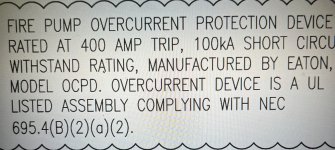hhsting
Senior Member
- Location
- Glen bunie, md, us
- Occupation
- Junior plan reviewer
I have fire pump 40HP 200V three phase with fla of 115A.
The contractor is providing ocpd as main service disconnect. I have not on plans that says ocpd is 400A trip and in compliance with NEC 2017 Article 695.4(B)(2)(a). See below.
The 400A trip is very questionable for 40Hp three phase 200V fire pump of 115A.
How can it comply withNEC 2017 Article 695.4(B)(2)(a)?

The contractor is providing ocpd as main service disconnect. I have not on plans that says ocpd is 400A trip and in compliance with NEC 2017 Article 695.4(B)(2)(a). See below.
The 400A trip is very questionable for 40Hp three phase 200V fire pump of 115A.
How can it comply withNEC 2017 Article 695.4(B)(2)(a)?



